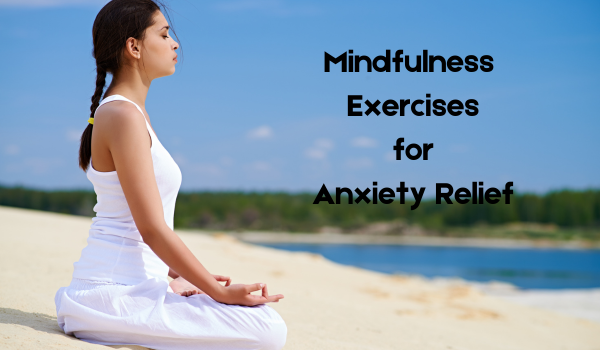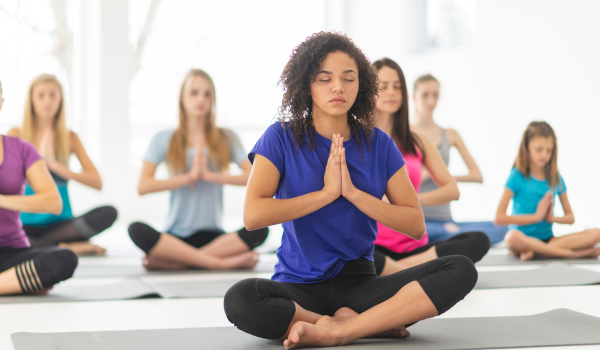Mindfulness exercises for anxiety relief

Introduction
Mindfulness exercises for anxiety relief is a buzzword you’ve probably heard lately, but what exactly is it? In simple terms, mindfulness is the practice of being fully present and engaged at the moment, aware of your thoughts and feelings without distraction or judgment. It’s like hitting the pause button on your life to take a deep breath and truly experience the world. This simple yet powerful practice has gained immense popularity for its ability to alleviate anxiety and bring about a sense of calm and clarity.
Understanding Anxiety
So, what exactly is anxiety? Anxiety is a feeling of worry, nervousness, or unease about something with an uncertain outcome. It’s a normal part of life to feel anxious occasionally, but for some, anxiety can be overwhelming and persistent. Common symptoms include restlessness, rapid heartbeat, and difficulty concentrating. Various factors, including genetics, brain chemistry, and life events, can contribute to anxiety.
The Science Behind Mindfulness and Anxiety Relief
How does mindfulness help with anxiety? When you practice mindfulness, you’re essentially training your brain to stay present and focused, which can help break the cycle of anxious thoughts. Research shows that mindfulness can reduce the activity in the amygdala, the part of the brain responsible for the fight-or-flight response, and increase activity in the prefrontal cortex, which is involved in decision-making and emotional regulation. Numerous studies support the effectiveness of mindfulness in reducing anxiety symptoms.

Benefits of Mindfulness for Anxiety Relief
The benefits of mindfulness for anxiety relief are extensive. By practicing mindfulness, you can learn to regulate your emotions better, leading to reduced stress levels and a greater sense of calm. Mindfulness also improves focus and concentration, helping you stay present and engaged in the task at hand rather than getting lost in anxious thoughts.
Basic Mindfulness Techniques
Ready to give mindfulness a try? Here are a few basic techniques to get you started:
- Breathing Exercises: Focus on your breath, inhaling deeply and exhaling slowly. This simple act can help calm your mind and body.
- Body Scan Meditation: Lie down and mentally scan your body from head to toe, noticing any areas of tension and consciously relaxing them.
- Mindful Walking: Take a walk and pay attention to the sensations of your feet touching the ground, the sights, and the sounds around you.
Advanced Mindfulness Practices
Once you’re comfortable with basic techniques, you might want to explore more advanced practices:
- Loving-Kindness Meditation: This practice involves sending love and positive thoughts to yourself and others.
- Mindfulness-Based Stress Reduction (MBSR): An eight-week program that combines mindfulness meditation and yoga to help manage stress and anxiety.
- Yoga and Mindfulness: Combining physical postures with mindfulness can enhance both practices.
Integrating Mindfulness into Daily Life
Mindfulness isn’t just about sitting quietly; it’s about bringing awareness to everyday activities:
- Mindful Eating: Pay attention to the taste, texture, and smell of your food, savoring each bite.
- Mindful Listening: Focus fully on the person speaking to you, without planning your response or getting distracted.
- Creating a Mindfulness Routine: Set aside a few minutes each day for mindfulness practice, gradually increasing the time as you become more comfortable.
Mindfulness Apps and Resources
There are plenty of resources to help you on your mindfulness journey:
- Top Mindfulness Apps: Apps like Headspace, Calm, and Insight Timer offer guided meditations and mindfulness exercises.
- Recommended Books and Websites: Books like “The Miracle of Mindfulness” by Thich Nhat Hanh and websites like Mindful.org provide valuable insights and practices.
Mindfulness Exercises for Specific Situations
Different situations call for different mindfulness techniques:
- Before a Stressful Event: Practice deep breathing or a quick body scan to calm your nerves.
- During an Anxiety Attack: Focus on your breath and grounding techniques to bring yourself back to the present moment.
- For Better Sleep: Try a guided meditation or body scan before bed to relax your mind and body.
Children and Mindfulness
Mindfulness isn’t just for adults; children can benefit too:
- Benefits for Children: Mindfulness can help kids manage stress, improve focus, and enhance emotional regulation.
- Simple Exercises for Kids: Activities like mindful breathing, sensory exercises, and guided imagery can be fun and engaging for children.
Mindfulness at Work
Work can be a major source of stress, but mindfulness can help:
- Techniques for Reducing Work-Related Stress: Practice short mindfulness exercises during breaks, like deep breathing or a quick body scan.
- Creating a Mindful Workspace: Keep your workspace organized and clutter-free, and add elements that promote calmness, like plants or calming images.
Mindfulness in Relationships
Mindfulness can enhance your relationships by improving communication and emotional connection:
- Enhancing Communication: Practice mindful listening, fully focusing on your partner without interrupting or planning your response.
- Building Emotional Connection: Engage in activities together mindfully, like cooking, walking, or simply sitting in silence.
Common Misconceptions about Mindfulness
There are a few common misconceptions about mindfulness that can deter people from practicing:
- Mindfulness vs. Meditation: While meditation is a form of mindfulness, mindfulness is not limited to meditation. It’s about being present in everyday activities.
- Mindfulness is Time-Consuming: You don’t need hours to practice mindfulness. Even a few minutes a day can make a difference.

Challenges and Solutions
Practicing mindfulness can come with challenges, but don’t let that discourage you:
- Common Challenges in Practicing Mindfulness: Distractions, impatience, and difficulty staying present are common hurdles.
- Tips for Overcoming These Challenges: Start small, be patient with yourself, and gradually increase your practice time. Using guided meditation can also be helpful.
Conclusion
In conclusion, mindfulness offers a powerful tool for managing anxiety and improving overall well-being. By incorporating mindfulness practices into your daily routine, you can experience the numerous benefits it offers, from emotional regulation to reduced stress levels. So, why not give it a try? Start small, be patient with yourself, and watch how mindfulness can transform your life.
FAQs
- What is mindfulness?
- Mindfulness is the practice of being fully present and engaged in the moment, aware of your thoughts and feelings without distraction or judgment.
- How does mindfulness help with anxiety?
- Mindfulness helps reduce anxiety by training your brain to stay present and focused, breaking the cycle of anxious thoughts.
- Can children practice mindfulness?
- Yes, children can practice mindfulness and benefit from improved focus, stress management, and emotional regulation.
- Do I need to meditate to be mindful?
- While meditation is a form of mindfulness, you can practice mindfulness in everyday activities like eating, walking, and listening.
- How much time do I need to practice mindfulness?
- Even a few minutes a day can be beneficial. Start small and gradually increase your practice time as you become more comfortable.





Hi my family member I want to say that this post is awesome nice written and come with approximately all significant infos I would like to peer extra posts like this